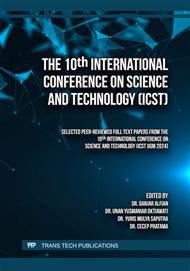[1]
European Union, What is GDPR, the EU's new data protection law?, GDPR.eu, (2018). [Online]. Available: https://gdpr.eu/what-is-gdpr/.
DOI: 10.1093/law-oeeul/e137.013.137
Google Scholar
[2]
B. McMahan, E. Moore, D. Ramage, S. Hampson, B. A. y Arcas, Communication-efficient learning of deep networks from decentralized data, Artif. Intell. Statist. (2017) 1273–1282.
Google Scholar
[3]
P. Kairouz, et al., Advances and open problems in federated learning, Found. Trends® Mach. Learn. 14 (2021) 1–210.
Google Scholar
[4]
C. Dwork, A. Roth, The algorithmic foundations of differential privacy, Found. Trends Theor. Comput. Sci. 9 (2014) 211–407.
Google Scholar
[5]
K. Bonawitz, et al., Practical secure aggregation for privacy-preserving machine learning, Proc. 2017 ACM SIGSAC Conf. Comput. Commun. Secur. (2017) 1175–1191.
DOI: 10.1145/3133956.3133982
Google Scholar
[6]
C. Gentry, Fully homomorphic encryption using ideal lattices, Proc. 41st Annu. ACM Symp. Theory Comput. (2009) 169–178.
DOI: 10.1145/1536414.1536440
Google Scholar
[7]
R.C. Geyer, T. Klein, M. Nabi, Differentially private federated learning: A client level perspective, arXiv:1712.07557 (2017).
Google Scholar
[8]
S. Kadhe, N. Rajaraman, O. O. Koyluoglu, K. Ramchandran, Fastsecagg: Scalable secure aggregation for privacy-preserving federated learning, arXiv:2009.11248 (2020).
Google Scholar
[9]
C. Dilmegan, What is Homomorphic Encryption? Benefits & Challenges, AI Multiple (2022). [Online]. Available: https://research.aimultiple.com/homomorphic-encryption/.
Google Scholar
[10]
W. Wang, Y. Hu, L. Chen, X. Huang, B. Sunar, Exploring the feasibility of fully homomorphic encryption, IEEE Trans. Comput. 64 (2013) 698–706.
DOI: 10.1109/tc.2013.154
Google Scholar
[11]
J. Konečný, H. B. McMahan, F. X. Yu, P. Richtárik, A. T. Suresh, D. Bacon, Federated learning: Strategies for improving communication efficiency, arXiv:1610.05492 (2016).
Google Scholar
[12]
J. Konečný, H. B. McMahan, D. Ramage, P. Richtárik, Federated optimization: Distributed machine learning for on-device intelligence, arXiv:1610.02527 (2016).
Google Scholar
[13]
Q. Yang, Y. Liu, Y. Cheng, Y. Kang, T. Chen, H. Yu, Federated learning, Synth. Lect. Artif. Intell. Mach. Learn. 13 (2019) 1–207.
Google Scholar
[14]
E. Kinnear, P. McManus, T. Pauly, T. Verma, C. A. Wood, RFC 9230 - Oblivious DNS over HTTPS, IETF (2022). [Online]. Available: https://datatracker.ietf.org/doc/rfc9230/.
DOI: 10.17487/rfc9230
Google Scholar
[15]
G. Rosinosky, S. Da Silva, S. Ben Mokhtar, D. Négru, L. Réveillère, E. Rivière, PProx: Efficient privacy for recommendation-as-a-service, Proc. 22nd Int. Middleware Conf. (2021) 14–26.
DOI: 10.1145/3464298.3476130
Google Scholar
[16]
S. Kalra, J. Wen, J. C. Cresswell, M. Volkovs, H. R. Tizhoosh, ProxyFL: Decentralized Federated Learning through Proxy Model Sharing, arXiv:2111.11343 (2021).
DOI: 10.21203/rs.3.rs-1168002/v1
Google Scholar
[17]
H. Shi, V. Radu, P. Yang, Distributed Training for Speech Recognition using Local Knowledge Aggregation and Knowledge Distillation in Heterogeneous Systems, Proc. 3rd Workshop Mach. Learn. Syst. (2023) 64–70.
DOI: 10.1145/3578356.3592591
Google Scholar
[18]
M. Brennaf, P. Yang, V. Lanfranchi, A Comparative Analysis of Federated Learning Techniques on On-Demand Platforms in Supporting Modern Web Browser Applications, 2023 IEEE 22nd Int. Conf. Trust Secur. Priv. Comput. Commun. (TrustCom) (2023) 2601–2606.
DOI: 10.1109/trustcom60117.2023.00363
Google Scholar
[19]
EPFL, epfml/disco: Decentralized & federated privacy-preserving ML training, using p2p networking, in JS, (2022). [Online]. Available: https://github.com/epfml/disco.
Google Scholar
[20]
C. Deotte, 25 Million Images! [0.99757] MNIST Kaggle, Kaggle (2021). [Online]. Available: https://www.kaggle.com/code/cdeotte/25-million-images-0-99757-mnist.
Google Scholar


